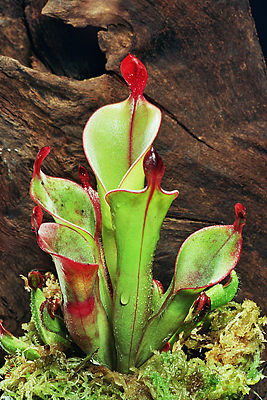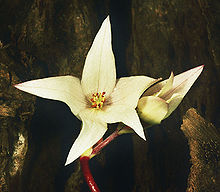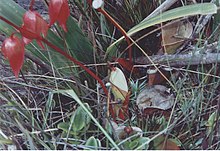Marsh jugs
| Marsh jugs | ||||||||||||
|---|---|---|---|---|---|---|---|---|---|---|---|---|

Heliamphora chimantensis (in culture) |
||||||||||||
| Systematics | ||||||||||||
|
||||||||||||
| Scientific name | ||||||||||||
| Heliamphora | ||||||||||||
| Benth. |
The heliamphora ( Heliamphora ) are a plant genus in the family Pitcher plants (Sarraceniaceae). They are precarnivorous plants.
description



Vegetative habit
The species of the genus Heliamphora are perennial herbaceous plants . Except for the Heliamphora file , which grows up to 4 meters high , all species form native rosettes. The simple or branched, robust rhizome forms horizontal runners and then grows upwards, creating more growth points. Starting from a single plant (especially with Heliamphora chimantensis ), extensive clumps of thousands of individuals that are several square meters in size can arise over decades . The fibrous, brown roots reach a length of up to 25 centimeters.
leaves
All Heliamphora species show an age-dependent leaf dimorphism , which means that the leaves of a young plant differ significantly in shape from those of an older one. The young leaves are almost the same shape in all species; the species-typical characteristics are only formed after up to 4 years.
The three to ten completely upright to slightly curved to the center of the rosette, funnel-shaped to cylindrical leaves are traps of the pitfall type and reach a height of 8 to 10 centimeters for Heliamphora minor and Heliamphora pulchella over 20 centimeters for Heliamphora nutans up to about half a meter at Heliamphora ionasii .
The traps have on the outer edge of the peristome (the edge of the tube opening) a very small, often high-contrast colored, ear-shaped or helmet-shaped, upright rudiment of the cover bent over the tube opening. An exception here is the species Heliamphora sarracenioides , whose lid, like a roof, covers the entire opening laterally and perpendicular to the inside of the trap and leaves only a small opening towards the center of the rosette. The outside of the traps is hairless, the inside of the funnel is covered in sections with downward-facing hair, which makes it difficult for prey that has fallen into it to escape. The shape of the traps prevents insects that have fallen in from flying out, as their wing movement creates a downward suction in the traps. At the front of the hose, the hoses have a so-called Ala , a wing that is densely covered with nectaries. Halfway up the ala there is a small opening through which excess rainwater can run off; a light hair in it acts as a sieve and prevents prey from being washed out.
Flowers, fruits and seeds
The few flowers on the long, upright inflorescence shafts are in a racemose inflorescence . The hermaphroditic flowers are radial symmetry . The mostly four, rarely five or six, pointed, egg-shaped petals are white (sometimes tinged with green) to red, in some species they change color from white to red in the course of the anthesis . There are ten to twenty stamens present. The ovary is upper and thickly hairy. There is only one stylus .
ecology
Carnivory
Ways of attracting insects are, on the one hand, the noticeable coloration of the leaves, especially the rudimentary lid, and, on the other hand, the reflection of the UV light solely through the inner leaf surface, which clearly distinguishes the trap opening from the surroundings and the outside of the leaf for insect eyes. This is supported by the secretion of nectar by nectar glands on the ala and particularly strongly on the lid rudiment, where other chemical attractants are also excreted. The hoses can be divided into four zones: Zone 1 is the rudiment of the lid, Zone 2 is the uppermost hose section and Zones 3 and 4 are the lower-lying sections of the hose. Each of these zones has a special function for catching prey, for which it is equipped differently. The first zone, the densely populated with Nektarien lid rudiment, separates larger amounts of strong fragrant nectar from and Sarracenin (an antimicrobial and predators abhaltendes iridoid ) Cineron (a insecticide precursor ), more than insect pheromones effective esters , phenylacetaldehyde (a chemical for communication among Insects), erucamide (a lubricant that keeps the secretion liquid and at the same time helps catch insects), numerous alkanes and xylene . These substances are often used to attract or catch prey insects, but may also have other such. B. numbing or sticky effects.
Insects that visit the plants strive to the rudiment of the lid (ground insects along the ala, flying insects directly) and either fall from there into the tube or are led to the inside of the tube by further nectaries. This way they get into zone 2, which is densely covered with downward-facing hair and which is only covered with nectar glands like islands. Since the downward-facing hairs block the way back to the edge, the insect can only move further downward until it reaches the abrupt beginning of zone 3, the surface of which is hairless and smooth, so that the animal slips down the tube and into the liquid rushes from zone 4 where digestion takes place.
So far, the production of enzymes by the plants themselves has only been demonstrated for one type of sump pitcher, Heliamphora , but here too only when the tubes are closed and young. Tests on some other species were unsuccessful. Thus (with the exception of Heliamphora tatei ) the genus is not to be classified as carnivorous in the strict sense, but as “precarnivorous”. Exactly how the prey is digested has not yet been established, but two hypotheses are considered likely: On the one hand, a bacterial fauna residing in the liquid could decompose the prey. On the other hand, so-called autolysis , i.e. self-dissolving of the prey, would be possible, because 80 to 95% of the prey of the marsh jugs consists of ants with an often predatory way of life, which bring digestive enzymes with them inside. Since enzymes have a catalytic effect, i.e. they do not consume or decompose, they could accumulate and serve to digest other prey, which in turn introduce enzymes again. It is also possible that several of these factors interact.
In addition to ants (preferably of the genera Linepithema , Camponotus and Solenopsis ), marsh jugs also prey on beetles , mosquitoes , sciarid gnats , two-winged fly , hymenoptera , and occasionally larger prey such as butterflies , scorpions or stone flies .
Marsh jugs develop many of the characteristics of their carnivory exclusively in extremely light-intensive locations, the overshadowing by vegetation or landscape features leads to a relatively slow growth rate and a lack of nectar secretion, the strong coloration, the hairiness and only weakly pronounced lid rudiments. This has led to the assumption that marsh jugs only need carnivory as an additional source of nutrients in situations where there is an increased need for nutrients (e.g. in the case of rapid growth due to optimal site conditions).
distribution
The genus Heliamphora is almost exclusively native to the so-called Tepuis , the difficult to access table mountains on the plateau in the border area between Brazil , Venezuela and Guyana . Only Heliamphora heterodoxa and Heliamphora sarracenioides can also be found in the lower elevations of this region.
evolution
For a long time, Heliamphora was thought to be one of the most pristine carnivorous plants because of its simple trap construction. However, recent genetic and flower biology studies suggest that Heliamphora probably has a long history of development and has only assumed its simple form in the recent past.
Systematics
Botanical history
The genus Heliamphora was established in 1840 by George Bentham in Proceedings of the Linnean Society of London , 1, p. 53.
The type species is Heliamphora nutans , which was first described by George Bentham in 1840 on the basis of a specimen collected by Robert Hermann Schomburgk . The generic name Heliamphora is composed of the ancient Greek names for "swamp" (ἕλος helos ) and "jug" (άμφορεύς amphoreus ). In the English-speaking world, the generic name was occasionally incorrectly translated as "Sun Pitcher" (from the Greek hel i os ).
The genus Heliamphora was monotypical for ninety years before Henry Allan Gleason described Heliamphora tatei in 1931 , Heliamphora tyleri, and Heliamphora minor in 1939 . Between 1978 and 1984 Julian Alfred Steyermark (who had already added Heliamphora heterodoxa to the genus in 1951 ) and Bassett Maguire continued to work on the genus and, in addition to numerous infraspecific taxa, also described two new species, Heliamphora ionasii and Heliamphora neblinae . Since 1999 - as a result of multiple expeditions and the sighting of existing herbarium material - a group of German researchers, consisting of Thomas Carow , Peter Harbarth , Joachim Nerz , Andreas Wistuba and Andreas Fleischmann , has rendered outstanding services to the genus and continuously described new species. the description of further taxa is still pending.
species
Up to 2010 19 species were described, making Heliamphora the most species-rich genus of the Sarraceniaceae . The exact taxonomy of this genus has not yet been clarified beyond doubt; in particular the status of Heliamphora tyleri and Heliamphora macdonaldae is controversial, with the view of a synonymy to Heliamphora tatei prevailing with regard to the status of Heliamphora tyleri .
- Heliamphora chimantensis Wistuba, Carow & Harbarth
- Heliamphora ciliata Wistuba, Mink & A. Fleischm.
- Heliamphora elongata mink
- Heliamphora exappendiculata (Maguire & Steyerm.) Mink & Wistuba
- Heliamphora folliculata Wistuba, Harbarth & Carow
- Heliamphora glabra (Maguire) Nerz, Wistuba & Hoogenstr.
- Heliamphora heterodoxa Steyerm.
- Heliamphora hispida Wistuba & Mink
- Heliamphora huberi A. Fleischm., Wistuba & Nerz
- Heliamphora ionasii Maguire
- Heliamphora macdonaldae Gleason
- Heliamphora minor Gleason
- Heliamphora neblinae Maguire
- Heliamphora nutans Benth.
- Heliamphora pulchella Wistuba, Carow, Harbarth & Nerz
- Heliamphora sarracenioides Carow, Wistuba & Harbarth
- Heliamphora tatei Gleason
- Heliamphora tyleri Gleason
- Heliamphora uncinata Mink, Wistuba & A. Fleischm.
literature
- Wilhelm Barthlott , Stefan Porembski, Rüdiger Seine, Inge Theisen: Carnivores. Biology and culture of carnivorous plants. Ulmer, Stuttgart 2004, ISBN 3-8001-4144-2 .
- Klaus Jaffe, Fabian Michelangeli, Jorge M. Gonzalez, Beatriz Miras, Marie Christine Ruiz: Carnivory in Pitcher Plants of the Genus Heliamphora (Sarraceniaceae). In: The New Phytologist. Vol. 122, No. 4, 1992, ISSN 0028-646X , pp. 733-744, JSTOR 2557442 .
- Francis Ernest Lloyd: The Carnivorous Plants (= A New Series of Plant Science Books. 9, ZDB -ID 415601-8 ). Chronica Botanica Company, Waltham MA 1942.
- Stewart McPherson: Pitcher Plants of the Americas. The McDonald & Woodward Publishing Company, Blacksburg VA 2007, ISBN 978-0-939923-74-8 .
Individual evidence
- ^ Daniel M. Joel, Barrie E. Juniper, Amots Dafni: Ultraviolet patterns in the traps of carnivorous plants. In: The New Phytologist. Vol. 101, No. 4, 1985, pp. 585-593, JSTOR 2432892 .
- ↑ Klaus Jaffé, Murray S. Blum, Henry M. Fales, Robert T. Mason, Aivlé Cabrera: On Insect Attractants from Pitcher Plants of the Genus Heliamphora (Sarraceniaceae). In: Journal of Chemical Ecology. Volume 21, No. 3, 1995, ISSN 0098-0331 , pp. 379-384, doi : 10.1007 / BF02036725 .
- ↑ Heliamphora at Tropicos.org. Missouri Botanical Garden, St. Louis, accessed August 29, 2017.





